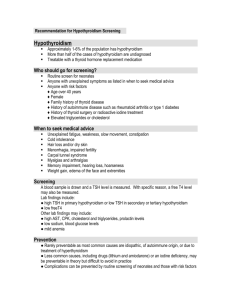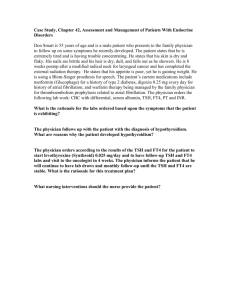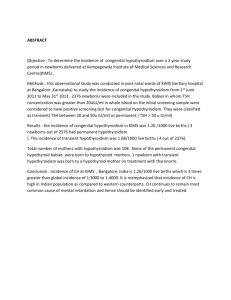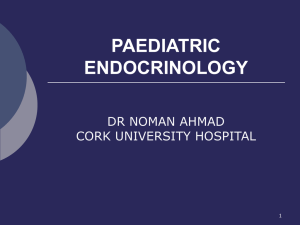Overtreatment of Congenital Hypothyroidism in the First Two Years
advertisement
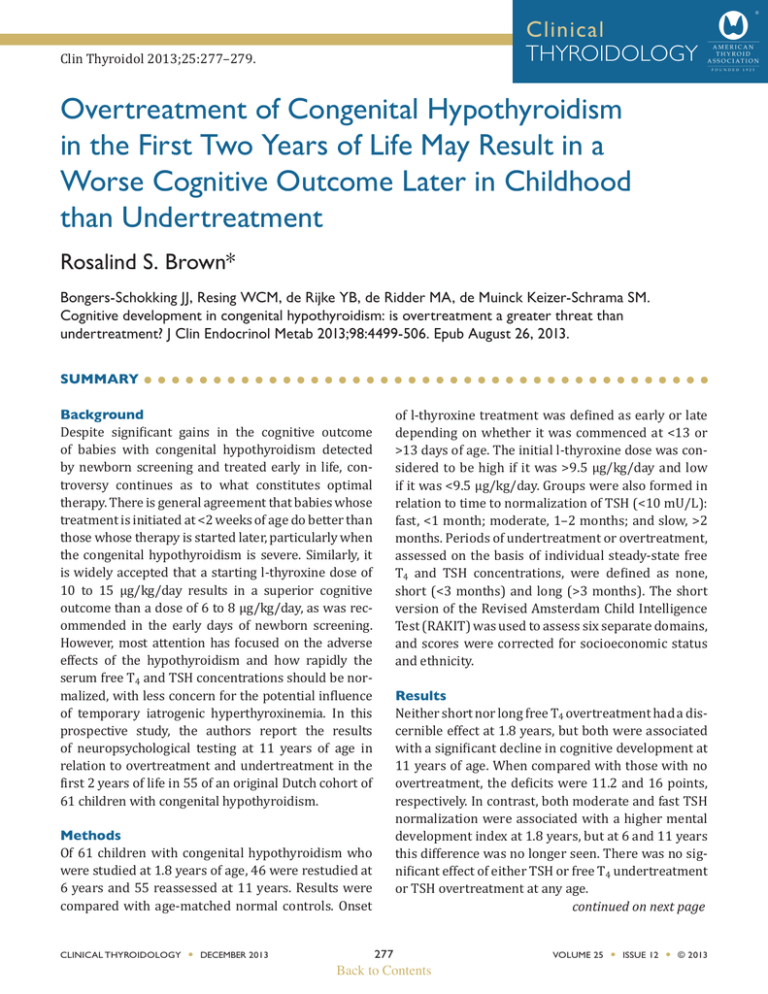
Clinical THYROIDOLOGY Clin Thyroidol 2013;25:277–279. Overtreatment of Congenital Hypothyroidism in the First Two Years of Life May Result in a Worse Cognitive Outcome Later in Childhood than Undertreatment Rosalind S. Brown* Bongers-Schokking JJ, Resing WCM, de Rijke YB, de Ridder MA, de Muinck Keizer-Schrama SM. Cognitive development in congenital hypothyroidism: is overtreatment a greater threat than undertreatment? J Clin Endocrinol Metab 2013;98:4499-506. Epub August 26, 2013. SUMMARY Background Despite significant gains in the cognitive outcome of babies with congenital hypothyroidism detected by newborn screening and treated early in life, controversy continues as to what constitutes optimal therapy. There is general agreement that babies whose treatment is initiated at <2 weeks of age do better than those whose therapy is started later, particularly when the congenital hypothyroidism is severe. Similarly, it is widely accepted that a starting l-thyroxine dose of 10 to 15 µg/kg/day results in a superior cognitive outcome than a dose of 6 to 8 µg/kg/day, as was recommended in the early days of newborn screening. However, most attention has focused on the adverse effects of the hypothyroidism and how rapidly the serum free T4 and TSH concentrations should be normalized, with less concern for the potential influence of temporary iatrogenic hyperthyroxinemia. In this prospective study, the authors report the results of neuropsychological testing at 11 years of age in relation to overtreatment and undertreatment in the first 2 years of life in 55 of an original Dutch cohort of 61 children with congenital hypothyroidism. Methods Of 61 children with congenital hypothyroidism who were studied at 1.8 years of age, 46 were restudied at 6 years and 55 reassessed at 11 years. Results were compared with age-matched normal controls. Onset CLINICAL THYROIDOLOGY l DECEMBER 2013 of l-thyroxine treatment was defined as early or late depending on whether it was commenced at <13 or >13 days of age. The initial l-thyroxine dose was considered to be high if it was >9.5 µg/kg/day and low if it was <9.5 µg/kg/day. Groups were also formed in relation to time to normalization of TSH (<10 mU/L): fast, <1 month; moderate, 1–2 months; and slow, >2 months. Periods of undertreatment or overtreatment, assessed on the basis of individual steady-state free T4 and TSH concentrations, were defined as none, short (<3 months) and long (>3 months). The short version of the Revised Amsterdam Child Intelligence Test (RAKIT) was used to assess six separate domains, and scores were corrected for socioeconomic status and ethnicity. Results Neither short nor long free T4 overtreatment had a discernible effect at 1.8 years, but both were associated with a significant decline in cognitive development at 11 years of age. When compared with those with no overtreatment, the deficits were 11.2 and 16 points, respectively. In contrast, both moderate and fast TSH normalization were associated with a higher mental development index at 1.8 years, but at 6 and 11 years this difference was no longer seen. There was no significant effect of either TSH or free T4 undertreatment or TSH overtreatment at any age. continued on next page 277 Back to Contents VOLUME 25 l ISSUE 12 l © 2013 Overtreatment of Congenital Hypothyroidism in the First Two Years of Life May Result in a Worse Cognitive Outcome Later in Childhood than Undertreatment Conclusions Overtreatment in the first 2 years of life as reflected by the free T4 concentration is more detrimental to later cognitive outcome than undertreatment. The rapidity Rosalind S. Brown of normalization of serum thyroid hormone and TSH levels, though associated with a short-term benefit, is not associated with a sustained improvement in neuropsychological performance later in childhood. ANALYSIS AND COMMENTARY This provocative study should cause us to pause and reconsider what constitutes optimal therapy for babies with congenital hypothyroidism, particularly those with severe disease who are the most at risk of neuropsychological sequelae. In particular, it challenges the overriding concern about the negative impact of prolonged hypothyroidism and the focus on correcting thyroid hormone levels ever more rapidly (1) by pointing out the potential negative impact of even short-term overtreatment. In clinical practice, it would not be feasible to compute a steady-state concentration of free T4 or TSH for every patient, and it would have been of interest to have been provided with the absolute values of these variables. Nonetheless, the authors quite rightly point out that based on their findings, it would be reasonable to aim for free T4 and TSH levels within the normal range in order to minimize the risk of overtreatment, rather than In the upper and lower half of normal, respectively, as currently recommended (2). It goes without saying that frequent monitoring of thyroid hormone levels is essential to achieve these goals, a point that has been emphasized by others recently (3). It is of interest that overtreatment as assessed by steady-state serum free T4 concentration, but not TSH, was associated with an adverse outcome at 11 years. The reason for this is not clear but could be a consequence of pituitary resistance, a relatively frequent finding in babies with congenital hypothyroidism in the first year of life (4). For the clinician, the take-home point is that the primary goal of therapy should be maintenance of a normal free T4 concentration. A final important and sobering lesson is the limited sensitivity and prognostic value of cognitive testing in the first year or two of life and the need for long-term follow-up in all such studies. In this, like other studies in the field (5,6), quite different conclusions would have been drawn had only results of cognitive testing at 1.8 years of age been available. With this in mind, I await with interest data concerning the long-term neuropsychological outcome of babies treated with a higher initial l-thyroxine dose (12 to 17 µg/kg/day) as advocated by some (1). Only when these data are available will it be possible to decide more rationally what truly constitutes optimal therapy in babies with congenital hypothyroidism. *Boston Children’s Hospital, Harvard Medical School References 1. Selva KA, Harper A, Downs A, et al. Neurodevelopmental outcomes in congenital hypothyroidism: comparison of initial T4 dose and time to reach target T4 and TSH. J Pediatr 2005;147:775-80. CLINICAL THYROIDOLOGY l DECEMBER 2013 2. Rose SR, Brown RS, Foley T, et al. Update of newborn screening and therapy for congenital hypothyroidism. Pediatrics 2006;117:2290-303. continued on next page 278 Back to Contents VOLUME 25 l ISSUE 12 l © 2013 Overtreatment of Congenital Hypothyroidism in the First Two Years of Life May Result in a Worse Cognitive Outcome Later in Childhood than Undertreatment 3. Balhara B, Misra M, Levitsky LL. Clinical monitoring guidelines for congenital hypothyroidism: laboratory outcome data in the first year of life. J Pediatr 2011;158:532-7. Epub November 20, 2010. 4. Fisher DA, Schoen EJ, La Franchi S, et al. The hypothalamic-pituitary-thyroid negative feedback control axis in children with treated congenital hypothyroidism. J Clin Endocrinol Metab 2000;85:2722-7. CLINICAL THYROIDOLOGY l DECEMBER 2013 Rosalind S. Brown 5. van Wassenaer AG, Kok JH, de Vijlder JJ, et al. Effects of thyroxine supplementation on neurologic development in infants born at less than 30 weeks’ gestation. N Engl J Med 1997;336:21-6. 6. van Wassenaer AG, Westera J, Houtzager BA, Kok JH. Ten-year follow-up of children born at <30 weeks’ gestational age supplemented with thyroxine in the neonatal period in a randomized, controlled trial. Pediatrics 2005;116:e613-8. Epub October 17, 2005. 279 Back to Contents VOLUME 25 l ISSUE 12 l © 2013
